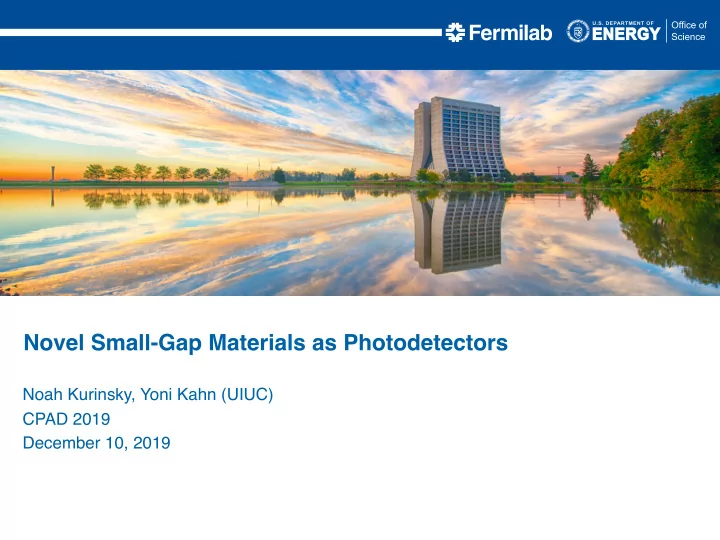

Novel Small-Gap Materials as Photodetectors Noah Kurinsky, Yoni Kahn (UIUC) CPAD 2019 December 10, 2019
DM Collision Kinematics • Recoil energy for a typical WIMP velocity depends on target mass and recoil type • Electron and nuclear recoils have Low Mass High Mass different kinematics; nuclear recoils are simple elastic collisions, electron recoils are largely inelastic and depend on electron orbital and kinematics within the bound electron-atom system • In addition to momentum transfer for a fixed velocity, using a velocity and angular distribution yields an expected √ 2 m T σ E energy spectrum m χ ,NR ≥ ◆ 2 max = m N v 2 ✓ 2 m χ 1 v q 2 ∆ E NR ≤ m χ ,ER ≥ 2 σ E 2 m N 2 m χ + m N v 2 2 µ N χ v 2 = m N v 2 ✓ ◆ m χ ∆ E ER ≤ 1 2 m χ + m N 2 3/19/2019 Noah Kurinsky
https://arxiv.org/pdf/1910.10716.pdf General Idea • Low-mass dark matter searches would greatly benefit from new detector materials with small gaps or long-lived phonon modes • In the case of materials with small energy gaps, the technology challenges are identical to the early days of Si, Ge, etc photodiodes, with some exceptions - We have the advantage of years of R&D into single-charge resolving Si detectors - We can reliably make APDs from many materials down to the single electron level, and SiPMs are a mature technology • Technology challenge: develop single charge resolved materials with small gaps at temperatures compatible with low dark rates - Driven by DM science - Inherently useful for other sub-eV processes • Motivates developing technology driven by intrinsic microphysics rather than heterostructures 3 12/10/2019 Noah Kurinsky
Classical Picture of Semiconductors • Charges produced, and minimum photon energy, determined by material bandgap • Bandgaps can be engineered, but only to some extent • Indirect bandgaps require more energy to liberate electrons thermally, but are still sensitive radiation down to bandgap energies (though the efficiency is reduced) 4 12/10/2019 Noah Kurinsky
Classical Picture of Semiconductors Updated • Charges produced, and minimum photon energy, determined by material bandgap • Bandgaps can be engineered, but only to some extent • Indirect bandgaps require more energy to liberate electrons thermally, but are still sensitive radiation down to bandgap energies (though the efficiency is reduced) 5 12/10/2019 Noah Kurinsky
From Sub-GeV DM Workshop (L. Wagner) https://astro.fnal.gov/ldm/ https://indico.fnal.gov/event/20385/session/55/contribution/39/material/slides/0.pdf 6 12/10/2019 Noah Kurinsky
From Sub-GeV DM Workshop (L. Wagner) https://astro.fnal.gov/ldm/ https://indico.fnal.gov/event/20385/session/55/contribution/39/material/slides/0.pdf 7 12/10/2019 Noah Kurinsky
Dirac materials for DM [Hochberg, YK , Lisanti, Zurek, Grushin, Ilan, Liu, Weber, Griffin, Neaton, Phys. Rev. D 2018, 1708.08929] 3D Dirac semimetal (ZrTe 5 ) 1 (a) (b 0.5 0 E-E F (eV) -0.5 -1 -1.5 Y Γ Z T S R • meV excitation energies • Anisotropic (bands and crystal) • (Theoretically) insulating at zero temperature Potential new class of materials for DM detection!
Recommend
More recommend